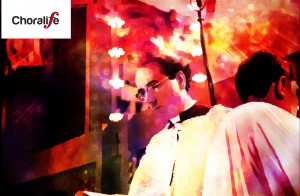Domenico Bartolucci (1917 – 2013)
Born May 7, 1917 in Borgo San Lorenzo, in the province of Florence, the Maestro showed at a very young age a dual vocation for religion and music. After completing the elementary school he entered the seminary in Florence where, in addition to ordinary studies, he devoted himself to music.
He studied with Francesco Bagnoli, Chapel Master of the Cathedral of Florence and soon was asked to accompany at the organ the choir performances in the Cathedral. The ease with which the young musician improvised Preludes, Toccatas and Fugues was immediately noted and generated the admiration of many Florentines. On the death of Bagnoli, he succeeded him as Director of the Chapel of the Cathedral of Florence. In those years he began to compose the first masses, motets, organ and chamber music, madrigals, but especially his first oratorio, The Storm on the Lake (1935). 1939 saw two decisive events: the ordination and the diploma in composition and conducting with Vito Frazzi at the Conservatory in Florence. At the end of 1942, after having taught in seminaries in Florence, he went to Rome to develop a deeper knowledge of sacred music, thanks to the then flourishing practice of musical Chapels. This was the beginning of his stay in the capital, as a guest at the Almo Collegio Capranica. He began to attend Raffaele Casimiri, a distinguished scholar of Palestrina, and started working alongside Lavinio Virgili as deputy director of the Chapel of St. John Lateran. The war and the bombing of Borgo San Lorenzo saw him head back to the Mugello, but in 1945, when the war ended, Bartolucci returned to Rome and achieved diplomas of composition perfectioning with Pizzetti and choral conducting.
Two years later Cardinal Dalla Costa appointed him parish priest of Montefloscoli, a small town in the Mugello region; after the performance of his Sacred Poem Baptisma at the Pontifical Institute of Sacred Music in Rome, he was appointed Master of the Liberian Chapel of Santa Maria Maggiore and professor of composition and polyphonic conduction right at the Pontifical Institute of Sacred Music. In 1952, on the advice of Lorenzo Perosi, Bartolucci became Deputy Master of the Sistine Chapel; in the same year he composed the oratorio The Ascension, with which he will inaugurate in Mexico City the new Sanctuary of the Virgin of Guadalupe, a religious event of large resonance in the Latin American hemisphere.Upon the death of Perosi in 1956, Pope Pius XII appointed him Perpetual Director of the Sistine Chapel. A few years later, in 1959, Bartolucci received the approval of Pope John XXIII for his project of reorganization of the Sistine Chapel Choir. As a result the Choir was given proper locations for rehearsals and for its archives, a stable team of adult singers was defined and the Schola puerorum, dedicated solely to the education of boys, was founded.Over the years, in addition to performances in the papal liturgies, Bartolucci has energically promoted the Sistine Chapel’s concert activity, deeming it a privileged instrument of evangelization. In this capacity, for over thirty-five years, the Papal Chapel took part to the International Festival of Music Chapels in Loreto and has given concerts throughout Italy. The Institution has been appreciated even beyond national borders through memorable tours (Austria, Germany, Ireland, France, Belgium, Netherlands, Spain, the Philippines, Australia, Canada, United States, Turkey, Japan) with hundreds of concerts that have received the appreciation of audience and critics for the singers and the conductor, therefore allowing the Sistine to keep alive its great polyphonic tradition. In addition to the direction of the Papal Chapel, Bartolucci has dedicated himself to teaching at the Conservatory of Santa Cecilia and the Pontifical Institute of Sacred Music, and has taught courses in Palestrina’s polyphony in Italy and abroad; he has also conducted Italy’s most notable choir-orchestra ensembles and was honored with the highest national and international awards.
In regards to composition, Bartolucci is the author of a vast musical production. The corpus of works already published by Editions Sistine Chapel includes over forty volumes, among which 6 books of motets, 6 of Masses, Lauds, Hymns, Songs, and a series of Masses and oratorios for soloists, choir and orchestra: the Nativity, Ascension, Passion, Storm on the Lake, Glorious Principes, Baptisma, Miserere, Te Deum, Stabat Mater, Missa pro defunctis, Missa Assumptionis, Jubilæi Missa, Missa de Angelis, Mass in honor of St. Cecilia, Biblical Cantata. In the secular field the most remarkable titles are the Sinfonia Mugellana, the Concerto for Piano and Orchestra in E, along with copious works for organ and piano, madrigals and chamber music. The Maestro’s most important work written for the theatre is the opera in three acts Brunellesco. For Bartolucci, music is based on natural, truthful expression, on the research of the most sincere and sontaneou way to interpret and communicate a concept. He has often remarked that he wants to shy away from abstractions and complicated oddities, preferring to follow the truth of words and gestures, enriched by the color and passion that characterize his personal temperament. A main tract of the whole aesthetic conception of the composer is that of a rational obedience to tradition, standing upon a basis of “a noble severity of singing and clear, solid polyphony”, as he indicated in the Preface of the First Book of Motets. Bartolucci’s music is rooted in the great tradition of Gregorian chant and polyphony of Palestrina’s, referring to their modal language, revived and enriched with a modern sensibility particularly loyal to the lyricism of the Roman School, although with some necessary updates due to the evolution of language and the passing of time. As a conductor, Bartolucci has absorbed the Roman lyrical tradition handed down by the singers of the Sistine Chapel Choir, all while refining and enhancing its features. His talents have led him to be recognized as the most authoritative interpreter of the polyphonic repertoire: in addition to the solemn papal liturgies, the countless concerts held by the Sistine Chapel in Italy and around the world have captured the attention of critics, who spoke often of authentic triumphs and established the Maestro as the last great polyphonist.
During the Ordinary Public Consistory held on November 20th, 2010, the Holy Father Benedictus XVI appointed him Cardinal for the generosity and dedication shown in his lifelong activity within the Church.
He passed away in Rome, on Monday, November 11th, 2013, at the age of 96.
Website
www.fondazionebartolucci.it
Facebook
https://www.facebook.com/domenico.bartolucci.58?fref=ts
Scores
Inviolata – SATB Choir
Alma Redemptoris Mater – SATB Choir
Misericordias Domini – STTB Choir






